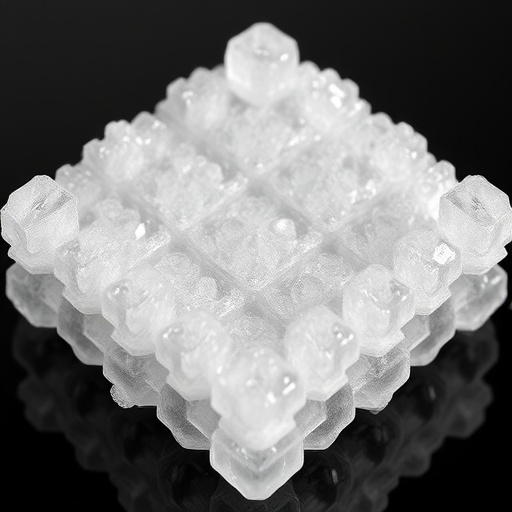In the quest for sustainable materials and innovative applications, the recent study conducted by Sasikumar et al. has delved into the fascinating realm of green synthesis, specifically focusing on the development of a hybrid composite consisting of silver oxide (Ag2O), magnesium oxide (MgO), and rice husk ash. This research, slated for publication in the journal Waste Biomass Valor, provides a significant leap in understanding the structural, dielectric, and antibacterial properties of this unique material. With the increasing demand for eco-friendly solutions, the processes and findings outlined in this study herald the emergence of advanced materials that could revolutionize several industries.
The green synthesis method employed in this study underscores the importance of using environmentally benign processes in the creation of composite materials. Traditional methods of synthesis often involve hazardous chemicals and energy-intensive processes that can have detrimental effects on both human health and the environment. By utilizing rice husk ash—a byproduct of rice processing—this study not only provides a sustainable approach to material synthesis but also opens the door for value addition to agricultural waste. The integration of silver oxide and magnesium oxide introduces enhanced functionalities, making this hybrid composite a competitive candidate for various applications.
In the structural assessment of the Ag2O/MgO/rice husk ash hybrid composite, the researchers employed advanced characterization techniques. The use of X-ray diffraction (XRD) revealed distinct crystalline phases, indicating successful synthesis and the formation of a stable microstructure. Besides, scanning electron microscopy (SEM) provided insights into the surface morphology of the composite, showcasing a rough and porous surface that enhances its potential in various applications. Such structural characteristics are crucial, as they influence not only the physical properties but also the performance of the composite in practical scenarios.
The dielectric properties of materials are paramount in the field of electronics and telecommunications. The hybrid composite’s dielectric response was meticulously evaluated in order to understand its behavior under varying frequencies and temperatures. The results indicated an impressive dielectric constant and low loss tangent, suggesting that this material could be effectively utilized in capacitor designs and energy storage systems. This finding is particularly timely as the demand for efficient energy storage solutions continues to escalate. A hybrid composite with strong dielectric properties may pave the way for greener technologies in energy management.
Perhaps one of the most intriguing aspects of this research is the antibacterial application of the Ag2O/MgO/rice husk ash composite. Silver oxide is renowned for its inherent antibacterial properties, making it a sought-after material in healthcare applications. The amalgamation of this oxide with magnesium oxide and rice husk ash not only enhances the material’s antibacterial efficacy but also makes it a viable candidate for biomedical applications, such as wound dressings. The findings of this research suggest that this hybrid composite could significantly reduce microbial growth, thus contributing to better health outcomes in clinical settings.
Environmental impacts associated with waste management are ongoing global challenges. By converting rice husk, an agricultural waste, into a high-value material, Sasikumar et al.’s research epitomizes the principles of a circular economy. This transformation provides an environmentally safe method of disposal for rice husks, which typically accumulate and pose disposal issues. In this regard, the study also offers insights into how other agricultural wastes could similarly be harnessed to create value-added products. This not only supports sustainability but also aligns with global efforts to minimize waste and maximize resource utilization.
The multifaceted applications of the Ag2O/MgO/rice husk ash composite extend beyond antibacterial properties. Its characteristics make it a strong contender for use in the construction industry, where composite materials that exhibit both strength and lightweight properties are highly coveted. The ability to incorporate such materials into building structures could potentially enhance durability and longevity while reducing dependence on conventional construction materials, which often have a significant carbon footprint.
Additionally, the implications of this study are far-reaching and can be envisaged in various industrial contexts. The hybrid composite could be leveraged in water purification technologies, where its porous structure may enhance the adsorption of pollutants, thus contributing to more efficient water treatment solutions. This versatility underscores the importance of interdisciplinary research, where chemistry, materials science, and environmental science converge to address pressing needs.
As industries transition towards greener alternatives, research such as Sasikumar et al.’s paves the way for innovative strategies that incorporate sustainable practices. The growing body of literature supporting green synthesis methods emphasizes the urgency of developing materials that not only perform well but are also environmentally friendly. As scientific advancements continue, the potential to discover new materials and applications will further support the evolution of sustainable engineering practices.
Looking ahead, the authors of this research highlight several avenues for future work, including scaling up synthesis methods and exploring the incorporation of additional biowaste materials into composite formulations. Such efforts will be crucial in further understanding the limitations and possibilities of bio-based composites. The burgeoning field of materials science is indeed ripe for exploration, with the promise of new discoveries yielding materials that provide both functional efficiency and ecological responsibility.
In conclusion, the research presented by Sasikumar et al. not only showcases the potential of the Ag2O/MgO/rice husk ash hybrid composite but also exemplifies the critical need for sustainable material development in today’s world. As society seeks solutions to mitigate environmental challenges, innovative approaches such as this could redefine the landscape of material science. Through continued investigation and application of green synthesis methods, researchers may significantly impact industries ranging from healthcare to construction, ultimately fostering a more sustainable and efficient future.
Subject of Research: Green synthesis of Ag2O/MgO/rice husk ash hybrid composite
Article Title: Green Synthesis and Characterization of Ag2O/MgO/Rice Husk Ash Hybrid Composite: Structural, Dielectric and Antibacterial Applications.
Article References:
Sasikumar, P., Mohanaparameswari, S., Balachandramohan, M. et al. Green Synthesis and Characterization of Ag2O/MgO/Rice Husk Ash Hybrid Composite: Structural, Dielectric and Antibacterial Applications. Waste Biomass Valor (2025). https://doi.org/10.1007/s12649-025-03328-7
Image Credits: AI Generated
DOI: 10.1007/s12649-025-03328-7
Keywords: Green synthesis, Hybrid composite, Ag2O, MgO, Rice husk ash, Antibacterial applications, Dielectric properties.




